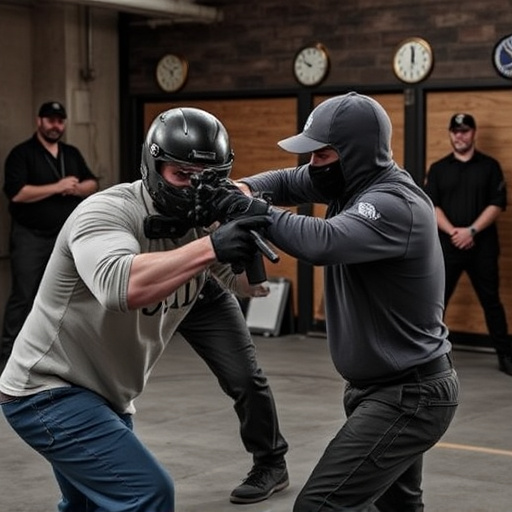Bulk Stun Guns: Understanding Voltage Penetration Through Clothing Thickness
Understanding voltage's behavior through materials, especially clothing thickness, is crucial f…….
Understanding voltage's behavior through materials, especially clothing thickness, is crucial for the effective and safe use of bulk stun guns in retail stores. Thicker fabrics act as insulators, slowing electric current flow, while thinner fabrics allow better current penetration. Vendors must select equipment accordingly, ensuring reliable stun effects while minimizing risks. Prioritizing safety, training, and compliance with local laws is essential when employing these powerful tools. Bulk stun guns cater to both security enthusiasts and those seeking protection, enhancing a store's appeal to safety-conscious buyers.
Voltage penetration through thick clothing is a fascinating yet often overlooked aspect of electrical safety. In this article, we explore how voltage behaves and its interactions with diverse fabric thicknesses. We delve into the world of bulk stun guns, focusing on their availability in retail stores, and discuss critical safety considerations for customers and staff alike. Understanding these factors is essential when assessing personal protection and ensuring responsible sales practices for bulk stun guns.
- Understanding Voltage and Its Behavior
- The Impact of Clothing Thickness on Penetration
- Bulk Stun Guns: A Retail Store Perspective
- Safety Considerations and Best Practices
Understanding Voltage and Its Behavior

Voltage, in simple terms, is a difference in electric potential energy between two points. In the context of bulk stun guns for retail stores and clothing, understanding how voltage behaves when passing through materials is crucial. When a stun gun delivers an electrical shock, it generates a high-voltage pulse that travels through the body’s electrical pathways, disrupting normal muscle function.
The thickness of clothing significantly influences the penetration depth of this voltage. Thicker fabrics act as insulators, slowing down and dissipating the electric current. This is why bulk stun guns designed for retail stores often come with guidelines on recommended clothing thickness to ensure effective shock delivery while minimizing risk to users.
The Impact of Clothing Thickness on Penetration

The thickness of clothing plays a significant role in determining how effectively voltage or electric current can penetrate it. When it comes to personal safety devices like bulk stun guns for retail stores, understanding this dynamic is crucial. Thicker garments, such as heavy jackets or armored vests, act as physical barriers, significantly impeding the flow of electricity. This isn’t just a theoretical concept; it’s why stun guns designed for self-defense often have lower voltage outputs compared to those meant for less protective clothing.
Clothing thickness can alter the path and intensity of electrical impulses, potentially reducing their impact on the target area. In retail store settings where bulk stun guns are considered, vendors must be mindful of this variable when choosing devices. Thinner fabrics allow for better current flow, ensuring a more reliable stun effect. Conversely, thicker clothing can make certain types of stun weapons less effective, necessitating adjustments in strategy and equipment selection to compensate.
Bulk Stun Guns: A Retail Store Perspective

Bulk Stun Guns for Retail Stores: A Comprehensive Look
In the dynamic retail landscape, offering customers innovative and effective self-defense options is paramount. Bulk stun guns have emerged as a popular choice among consumers seeking immediate protection in potentially dangerous situations. As a retailer, stocking these powerful tools can significantly enhance your store’s appeal to safety-conscious buyers. Stun guns are designed to penetrate thick clothing, ensuring their effectiveness in various scenarios where conventional self-defense might falter. This makes them an attractive addition to any retail store’s inventory, catering to both personal security enthusiasts and those seeking reliable protection on the go.
When considering bulk stun gun purchases for your retail establishment, several factors come into play. Firstly, focus on acquiring high-quality products from reputable manufacturers. Quality ensures not only optimal performance but also user safety. Secondly, diversify your offerings based on different power levels, sizes, and features to cater to a broader customer base. Lastly, stay updated with the latest industry standards and legal regulations regarding stun guns to ensure compliance and maintain customer trust.
Safety Considerations and Best Practices

When considering the use of stun devices, especially bulk stun guns for retail stores, it’s crucial to prioritize safety. These powerful tools can penetrate clothing, but they should only be employed as a last resort and in accordance with local laws. Always ensure proper training for staff and customers alike, emphasizing responsible usage and de-escalation techniques.
Best practices involve keeping bulk stun guns readily available in high-risk areas and displaying them visibly to deter potential threats. Regular maintenance checks on the devices are essential, including testing the functionality and ensuring the device is in optimal working condition. Additionally, fostering an environment of awareness and mutual respect among customers can significantly reduce instances where such devices become necessary.
In understanding the voltage penetration through thick clothing, this article has explored key aspects from both theoretical and practical perspectives. It’s clear that clothing thickness significantly impacts voltage transmission, with bulkier fabrics acting as effective barriers against electric current flow. This knowledge is particularly relevant for retail stores considering the stocking of bulk stun guns, which operate on the principle of high-voltage discharge to incapacitate targets. By adopting safety best practices and staying informed about these findings, retailers can ensure responsible and effective use of such devices while prioritizing customer well-being.


